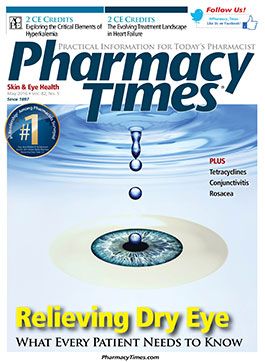Publication
Article
Pharmacy Times
Vraylar
Author(s):
The FDA has approved Vraylar, an atypical antipsychotic, for the treatment of schizophrenia and the acute treatment of mixed or manic episodes associated with bipolar I disorder.

The FDA has approved Vraylar (cariprazine), an atypical antipsychotic, for the treatment of schizophrenia and the acute treatment of mixed or manic episodes associated with bipolar I disorder.1 Schizophrenia affects approximately 2.6 million Americans; bipolar I disorder affects approximately 3.6 million.2
Pharmacology and Pharmacokinetics
Although the exact mechanism of Vraylar is unknown, it may be mediated through a combination of partial agonist activity at central dopamine D2 and serotonin 5-HT1A receptors and antagonist activity at serotonin 5-HT2A receptors. Vraylar does not have appreciable affinity for cholinergic muscarinic receptors.1,2
Vraylar has 2 major active metabolites, which are pharmacologically equipotent to Vraylar. Vraylar is extensively metabolized by cytochrome P3A4 (CYP3A4) and to a lesser extent by CYP2D6. The metabolites of Vraylar are then metabolized by CYP3A4 and CYP2D6. Upon discontinuation of Vraylar, the plasma concentrations of Vraylar and its active metabolites decline in a multi-exponential manner.1
Dosage and Administration
For the treatment of schizophrenia, the recommended dose range is 1.5 to 6 mg/day. Vraylar should be initiated at 1.5 mg/day, and the dose may be increased to 3 mg/day on day 2. Subsequent dose increases depend on clinical response and tolerability, and can occur at increments of 1.5 or 3 mg/day. For the treatment of mixed or manic episodes associated with bipolar I disorder, the recommended dose range is 3 to 6 mg/day, with a starting dose of 1.5 mg/day and an increase to 3 mg/day on day 2. Depending on clinical response and tolerability, subsequent dose increases can occur at increments of 1.5 or 3 mg/day.1
Clinical Trials
The efficacy of Vraylar for the treatment of schizophrenia was evaluated in 1754 adult patients in three 6-week, randomized, double-blind, placebo-controlled trials. Two studies included an active control arm (risperidone or aripiprazole). The primary end point was the Positive and Negative Syndrome Scale rating scale; the secondary end point was the Clinical Global Impressions- Severity (CGI-S) rating scale. Each trial demonstrated Vraylar to be superior to placebo in both the primary and secondary end points.
The efficacy of Vraylar for the acute treatment of bipolar mania was evaluated in 1037 adult patients in three 3-week, placebo-controlled trials. The primary end point was the Young Mania Rating Scale; the secondary end point was the CGI-S. Vraylar was determined to be superior to placebo in both end points in each trial.1,3
Contraindications, Warnings, and Precautions
Vraylar carries a boxed warning regarding the increased risk of death in elderly patients with dementia-related psychosis who are treated with antipsychotic medications. The warning also states that Vraylar is not approved for the treatment of patients with dementia-related psychosis.
Vraylar also is contraindicated in patients with a known hypersensitivity to the medication. Vraylar should be discontinued immediately if neuroleptic malignant syndrome occurs. Discontinuation may be warranted if tardive dyskinesia occurs. Adverse effects (AEs) and therapeutic response may occur several weeks after starting Vraylar and with each dosage change; patients should be monitored appropriately. Patients using Vraylar should also be monitored for metabolic changes, such as hyperglycemia/diabetes, dyslipidemia, and weight gain. Atypical antipsychotics can cause orthostatic hypotension and syncope. Use of Vraylar during pregnancy may result in extrapyramidal and/or withdrawal symptoms in neonates with third-trimester exposure.
When used concomitantly with strong CYP3A4 inhibitors, the dose of Vraylar should be reduced by half. Concomitant use of CYP3A4 inducers with Vraylar should be avoided. When used for the treatment of schizophrenia, the most common AEs (≥5%) were extrapyramidal symptoms and akathisia. When used for the treatment of bipolar mania, the most common AEs (≥5%) were extrapyramidal symptoms, akathisia, dyspepsia, vomiting, somnolence, and restlessness.1
Dr. Holmberg earned her PharmD from the University of Connecticut and completed an ambulatory care residency at the Phoenix VA Healthcare System. Her practice has also included pediatrics and inpatient mental health. She resides in Phoenix, Arizona.
References
- Vraylar [package insert]. Parsippany, NJ: Actavis, Inc; 2015.
- Allergan and Gedeon Richter Plc receive FDA approval of Vraylar (cariprazine) for treatment of manic or mixed episodes of bipolar I disorder and schizophrenia in adults [news release]. Dublin, Ireland, and Budapest, Hungary: Allergan website; September 17, 2015. allergan.com/news/news/thomson-reuters/allergan-and-gedeon-richter-plc-receive-fda-approv. Accessed January 2016.
- FDA approves new drug to treat schizophrenia and bipolar disorder [press release]. Silver Spring, MD: FDA; September 17, 2015. www.fda.gov/NewsEvents/Newsroom/PressAnnouncements/ucm463103.htm. Accessed January 2016.







